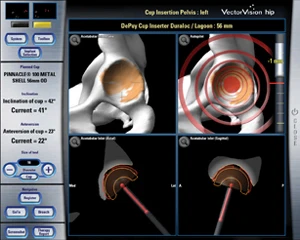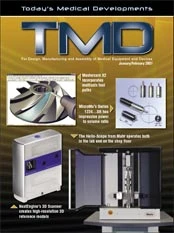
Since the mid ‘70s, medical procedures have undergone some pretty drastic changes, transforming surgery as we know it for the better. Computers are making their way into operating rooms, lending their helping hand in various surgeries. Computer Assisted Surgery (CAS) technologies provide physicians and surgical teams with three-dimensional views of surgery areas, enabling more precise positioning of surgical instruments. This is very good news for patients. By using CAS, procedures become shorter and less invasive, while patient safety increases and patient morbidity decreases.
TOTAL HIP ARTHROPLASTY WELCOMES CAS:
During their time in medical school, orthopedic surgeons are taught that "surgical exposure" is a crucial factor when performing successful total hip arthroplasty (THA).
Traditional methods of performing this type of surgery severely limit clear visualization of key bony landmarks. This has made it difficult for surgeons to achieve accurate fixation and orientation of the implants, resulting in the exposure of significant amounts of skeletal bone. This makes THA a more invasive surgery and leads to other complications, such as long patient recovery time, blood loss and ossification.
A team of doctors from the Institute for Computer Assisted Orthopedic Surgery, The Western Pennsylvania Hospital and the Department of Orthopedic Surgery at the University of Pittsburgh Medical Center wanted to begin utilizing advanced surgical procedures. This would improve patient outcome by disrupting less soft tissue and reducing pain, decreasing recovery time and allowing for fewer complications. They believed that surgical navigation technologies and computer assisted tools would be the base for achieving less invasive techniques when performing THA.
The team of doctors focused their study on the results of using a mini-incision surgical technique, enabled by surgical navigation tools, for THA. Using this technique, 121 patients and 137 hips underwent surgery. The same surgeon operated on all patients, and all CAS procedures were performed using an image-guided navigation system. The system used in these surgeries had software that registered and matched a preoperative CT scan to the patients' position on the operating table, allowing the surgeon to become accurately oriented with the implant area without full visualization of bony landmarks. Optical light-emitting diode (LED) frames were attached to each patient's pelvis and to the surgical instruments, giving the surgeon accurate orientation of the anatomy and the ability to track surgical instruments and implants in real time during the procedure.

CAS being used in the mechanical alignment during a TKA procedure.
Using CAS for these THA procedures made a big impact on the surgical process, and on patient outcomes. The size of the incision and the soft tissue dissection were both reduced by an average of 50%. After only three months, patients who received the mini-incision surgery showed significant improvement in their limp. At six months examination, the same patients were showing significant improvements when walking distances and climbing stairs. These patients also used significantly less in blood transfusions during the post-operative phase.
CAS IN TOTAL KNEE ARTHROPLASTY
The primary goal of total knee arthroplasty (TKA) is mechanical alignment of the limbs. This is challenging, because the final position of the implanted prosthesis cannot be assessed accurately until an x-ray is taken, after surgery. Mechanical tools are available to the surgeon intra-operatively to assist in cutting bone at the required angle. However, once the bone is cut, the surgeon must rely on skill and judgment for optimal positioning of the implant.
A randomized trial was conducted in order to see whether computers made a significant difference in patient outcome when compared to traditional methods. Out of 240 procedures, half of the TKA surgeries were performed using a CAS navigation system, and the other 120 were performed using only traditional instrutrials used a CAS system to navigate the femoral and tibial cuts and the placement of the implants. For both methods, all degrees of freedom were assessed, recorded and evaluated for comparison.
This study demonstrated that with the use of computer assistance, surgical navigation can produce more consistent and more predictable results. In the group that received CAS, only three patients had a deviation greater than the standard 3° in their femoral-tibial axial alignment. Twenty- seven patients from the other group had deviations. The post-operative comparison for correct flexion position showed that 80% of implants among the navigated group were in the correct position, while only 22% of implants in the traditional instrumentation group were in the correct position. Also, tibial alignment was notably better in the CAS navigated group.
Computer Assisted Surgery is growing in popularity because of its dependable results and because of its invaluable use of technology. Not only can computers improve upon hip and knee replacement surgeries, but they apply to brain surgeries, ear, nose and throat (ENT) medicine, spinal surgeries and orthopedic trauma surgeries. The continuous discovery and application of these advanced technologies in medical surgery can provide significant long-term benefits to physicians, patients and their families, hospitals and the health care system within the United States and across the world.

Explore the January February 2007 Issue
Check out more from this issue and find your next story to read.
Latest from Today's Medical Developments
- The role of robotics in precision medical device manufacturing
- Swiss Steel Group’s UGIMA-X machinable stainless-steel sets
- #51 - Manufacturing Matters - The Impact of M&A in MedTech 2024
- Visual Components: 25 years of simulation and programming software innovation
- Zimmer Biomet announces definitive agreement to Acquire Paragon 28
- Discover an innovative technology for EMI/ESD/TVS suppression
- Teleflex to acquire BIOTRONIK’s Vascular Intervention business
- Innovation at Global Industrie 2025





